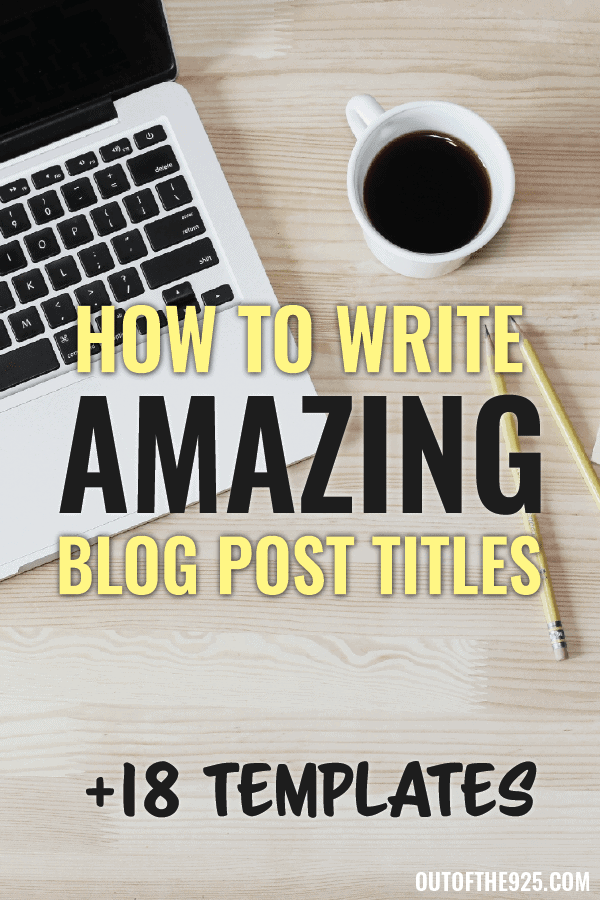In this article, you’ll find out how to make the best blog post titles and you’ll receive 18 catchy blog titles to increase the click-through rate on your articles.
Most people spend considerable time thinking about the content of their blog posts. This is great, generally speaking, time invested = better quality, and I love reading well-written and thought-out articles. Blog post titles, on the other hand, are hardly given a second thought, and this is a huge mistake.
Here’s why;
- A title is meant to draw a potential reader into your post. What’s the point of having the best content if no one is going to read it?
- If you have a generic, uninspired, and frankly unclick-worthy title, you’re telling readers that they can just skip this.
If someone comes across your article in a Google search, they’ll probably be drawn to a more interesting and persuasive title and your ranking will matter about as much as a cat at a dog show.
This goes for social networks like Facebook, Pinterest, and YouTube as well.
- What do catchy blog post titles look like?
- 18 Best blog post titles to increase your click-through rate
- 1. ‘How to…’
- 2. ‘X ways to solve Y’
- 3. ‘X things about Y’
- 4. Why, what , and where.
- 5. ‘X … you need…’
- 6. ‘Who’ posts
- 7. ‘What no one will tell you about…’
- 8. ‘The Ultimate Guide to…’
- 9. ‘Where to find…’
- 10. ‘What to…’
- 11. ‘X … Mistakes I wish I knew earlier!’
- 12. ‘…: Everything you need to know before…’
- 13. ‘An in-depth Guide to…’
- 14. ‘Question’ titles
- 15. ‘Better than’ Comparisons
- 16. ‘Vs’ Comparison
- 17. ‘Here’s why’ titles
- 18. ‘Stop’ titles

If you want to read this later, please save it to Pinterest.
What do catchy blog post titles look like?
It doesn’t have to be complicated;
Catches attention and creates curiosity
You want to create a sense of need for your readers, a sense that they need to find out more.
A good catchy blog post title does this by creating curiosity that catches the reader’s attention.
Deliver on your headline
Good titles create curiosity without the need for false promises.
Clickbait is just going to cause people to skip over your content and generate a whole lot of negativity around your social media accounts and website. Clickbait in itself isn’t negative, but people use it in a negative way. If you create a clickable blog post title and then deliver on what you promised in the title, that’s positive clickbait and no one is going to have any complaints.
While in some circles all publicity may be good publicity, I tend to usher on the side of bad publicity is bad publicity – stay the heck away!
Add emotion and a spark to your titles
Just because you shouldn’t use negative clickbait does not mean that you should avoid clickable titles altogether. A good way to incorporate this on your website is by adding emotion to your titles.
I.e. Instead of writing “5 things I did not like about living in Paris, France”, a better title would be “5 Things I Hated in Paris & Why I’m Never Going Back!”
The post could be the same article, but the second post creates a strong sense of intrigue, “What could’ve been so bad that he’ll never go back?”
Contrary to the negative, words like “Incredible” and “Amazing” are strong words that could be used to emphasize a positive event or article.
Keep Search Engine Optimization in mind
Free SEO Tools like Google’s Keyword Planner can help you determine if anyone is looking for articles with your proposed title.
Keywords with a good amount of monthly searches and relatively low competition can be your key to getting good traffic if you optimize the rest of your posts well around them.
You can also use tools like Ubersuggest, Ahrefs, SEMrush, etc., but you will have to pay if you want to use them frequently.
The best blog post titles are less than 60 characters long
By limiting your titles to 60 characters, you’re making sure that the full title shows up in the search, which can be vital if the fundamental parts of your title are towards the end.
This also helps you get straight to the point, readers have a short attention span when assessing if your article is the solution to their problem.
To make things easier, next up I’ve set out 18 Blog Title templates, with some practical examples and why they would be good titles for your articles or blog posts.
18 Best blog post titles to increase your click-through rate
1. ‘How to…’
How-to articles are some of the most popular articles you’ll find both online and printed.
Blogs love them (and so do I), it’ll only take a quick perusal of your favorite blog feed to see how popular these types of titles can be.
The reason why they’re so popular is that the reader knows that they will learn something from the article, generally a skill they haven’t yet mastered.
Example: How to conquer your arachnophobia in minutes
2. ‘X ways to solve Y’
People love lists, they are structured, they let the reader know how long and how much information is in an article & they can consume them in digestible portions.
Lists that involve solving problems are even better as the reader knows that after the steps or different methods are completed, they will have solved their problem.
Example: 7 genius ways to solve your concentration problems today

3. ‘X things about Y’
Much like the previous point, this title tells the reader exactly what the topic is what they can expect from the post.
Example: 5 things I loved about starting a business at 18
4. Why, what , and where.
These titles give information on the topic and are loved by search engines. If you have a problem and you’re looking for information online, what you would type in generally starts with one of these words.
Example: Why I couldn’t fall asleep and what I’ve done to solve it for good!
Example: Where to find the absolute best Pizza in Rome.
5. ‘X … you need…’
Titles like these give clear structure and generally involve items that the reader can acquire to solve their problem.
Example: 7 incredible experiences you need to have before the age of 25
6. ‘Who’ posts
If you’re able to use testimonials or examples in your article, ‘who’ titles let your readers know what the topic is and how well the ‘who’ is doing. These could be used for motivation or inspirational posts, but ‘what not to do’ posts as well.
Example: 5 awesome travelers who are killing it on Instagram
Example: 5 Huge Streamers who have been banned by Twitch this year
7. ‘What no one will tell you about…’
These types of titles are great because you’re insinuating that you have information that no one else has and the reader may receive some inside information. Here you’ll want to make sure your article is either very comprehensive or holds some information that you can’t find easily online.
Example: What no one will tell you about Paleo, behind the miracle diet.
8. ‘The Ultimate Guide to…’
Readers like to go through guides because they usually have a comprehensive and complete overview of a topic.
Example: The Ultimate Guide to Peru: How to Survive Winter.
9. ‘Where to find…’
Great for search engines, these titles get straight to the point. They provide a solution to someone’s problem and answer questions.
Example: Where to find uncrowded crystal-clear beaches in Southern France.
10. ‘What to…’
Same as above.
Example: What to know about your first marathon, how to beat the wall.
11. ‘X … Mistakes I wish I knew earlier!’
The easiest way to learn is from your own mistakes, a better way to learn though is from someone else’s. That makes these headlines very clickable.
Example: 10 Simple Pinterest mistakes I wish I knew earlier!
12. ‘…: Everything you need to know before…’
Another title that clearly defines the topic and promises the reader a complete guide to whatever your topic is.
Example: Hosting: Everything you need to know before deciding on a hosting company!
13. ‘An in-depth Guide to…’
Another guide that will provide a lot of information on a topic or subject for the reader.
Example: An In-depth Guide to seeing the brilliant Northern Lights in Norway.
14. ‘Question’ titles
These promise the reader an answer to their problems, much like the ‘What’ & ‘Where’ titles.
Example: When is the perfect time to visit New York? Season highlights.
15. ‘Better than’ Comparisons
A clear comparison between the two subjects. Generally pointing out why X is better than Y.
Example: Is Apple better than Microsoft? The truth will shock you!
16. ‘Vs’ Comparison
Similar to ‘better than’ comparisons, these titles indicate a more unbiased comparison.
Example: Samsung vs Sony: Which giant really makes the best TV?
17. ‘Here’s why’ titles
These present a negative at first, something that captures the attention. Then the ‘here’s why’ promises to present enlightenment within the article.
Example: Facebook is completely ruining your life, here’s why.
18. ‘Stop’ titles
These titles work because they tell you what you’re doing wrong and why and how you can fix them.
Who wouldn’t want to read that?
Example: 10 health warnings you need to stop ignoring right now

If you enjoyed this article, please save it to Pinterest.
As you can see, with a bit of thought, eye-catching and intriguing blog post titles can be quite easy to create. Invest a few minutes to think out the foundation of your title and build it out using some of these templates.
You’ll notice I’ve used 2 to 3 of these templates in most of the examples I’ve included.
Don’t limit yourself to one template, mix and match until you get something that really stands out and is just as good as the content you’re sending out into the world.



